Role of polynucleotide kinase/phosphatase in mitochondrial DNA repair
- PMID: 22210862
- PMCID: PMC3333865
- DOI: 10.1093/nar/gkr1245
Role of polynucleotide kinase/phosphatase in mitochondrial DNA repair
Abstract
Mutations in mitochondrial DNA (mtDNA) are implicated in a broad range of human diseases and in aging. Compared to nuclear DNA, mtDNA is more highly exposed to oxidative damage due to its proximity to the respiratory chain and the lack of protection afforded by chromatin-associated proteins. While repair of oxidative damage to the bases in mtDNA through the base excision repair pathway has been well studied, the repair of oxidatively induced strand breaks in mtDNA has been less thoroughly examined. Polynucleotide kinase/phosphatase (PNKP) processes strand-break termini to render them chemically compatible for the subsequent action of DNA polymerases and ligases. Here, we demonstrate that functionally active full-length PNKP is present in mitochondria as well as nuclei. Downregulation of PNKP results in an accumulation of strand breaks in mtDNA of hydrogen peroxide-treated cells. Full restoration of repair of the H(2)O(2)-induced strand breaks in mitochondria requires both the kinase and phosphatase activities of PNKP. We also demonstrate that PNKP contains a mitochondrial-targeting signal close to the C-terminus of the protein. We further show that PNKP associates with the mitochondrial protein mitofilin. Interaction with mitofilin may serve to translocate PNKP into mitochondria.
Figures
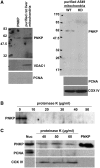
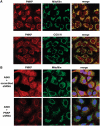

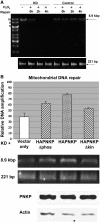
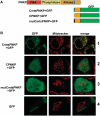

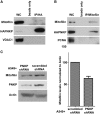
Similar articles
-
Molecular cloning of the human gene, PNKP, encoding a polynucleotide kinase 3'-phosphatase and evidence for its role in repair of DNA strand breaks caused by oxidative damage.J Biol Chem. 1999 Aug 20;274(34):24176-86. doi: 10.1074/jbc.274.34.24176. J Biol Chem. 1999. PMID: 10446192
-
Role of human DNA glycosylase Nei-like 2 (NEIL2) and single strand break repair protein polynucleotide kinase 3'-phosphatase in maintenance of mitochondrial genome.J Biol Chem. 2012 Jan 20;287(4):2819-29. doi: 10.1074/jbc.M111.272179. Epub 2011 Nov 30. J Biol Chem. 2012. PMID: 22130663 Free PMC article.
-
Molecular characterization of Plasmodium falciparum putative polynucleotide kinase/phosphatase.Mol Biochem Parasitol. 2011 Nov;180(1):1-7. doi: 10.1016/j.molbiopara.2011.06.007. Epub 2011 Jul 23. Mol Biochem Parasitol. 2011. PMID: 21821066
-
Early steps in the DNA base excision/single-strand interruption repair pathway in mammalian cells.Cell Res. 2008 Jan;18(1):27-47. doi: 10.1038/cr.2008.8. Cell Res. 2008. PMID: 18166975 Free PMC article. Review.
-
Polynucleotide kinase as a potential target for enhancing cytotoxicity by ionizing radiation and topoisomerase I inhibitors.Anticancer Agents Med Chem. 2008 May;8(4):358-67. doi: 10.2174/187152008784220311. Anticancer Agents Med Chem. 2008. PMID: 18473721 Free PMC article. Review.
Cited by
-
Recessive cerebellar and afferent ataxias - clinical challenges and future directions.Nat Rev Neurol. 2022 May;18(5):257-272. doi: 10.1038/s41582-022-00634-9. Epub 2022 Mar 24. Nat Rev Neurol. 2022. PMID: 35332317 Review.
-
PNKP is required for maintaining the integrity of progenitor cell populations in adult mice.Life Sci Alliance. 2021 Jul 5;4(9):e202000790. doi: 10.26508/lsa.202000790. Print 2021 Sep. Life Sci Alliance. 2021. PMID: 34226276 Free PMC article.
-
The maintenance of mitochondrial DNA integrity--critical analysis and update.Cold Spring Harb Perspect Biol. 2013 May 1;5(5):a012641. doi: 10.1101/cshperspect.a012641. Cold Spring Harb Perspect Biol. 2013. PMID: 23637283 Free PMC article. Review.
-
The Classification of Autosomal Recessive Cerebellar Ataxias: a Consensus Statement from the Society for Research on the Cerebellum and Ataxias Task Force.Cerebellum. 2019 Dec;18(6):1098-1125. doi: 10.1007/s12311-019-01052-2. Cerebellum. 2019. PMID: 31267374 Free PMC article. Review.
-
Structure and function of the DNA ligases encoded by the mammalian LIG3 gene.Gene. 2013 Dec 1;531(2):150-7. doi: 10.1016/j.gene.2013.08.061. Epub 2013 Sep 5. Gene. 2013. PMID: 24013086 Free PMC article. Review.
References
-
- Henner WD, Grunberg SM, Haseltine WA. Sites and structure of gamma radiation-induced DNA strand breaks. J. Biol. Chem. 1982;257:11750–11754. - PubMed
-
- Lennartz M, Coquerelle T, Bopp A, Hagen U. Oxygen—effect on strand breaks and specific end-groups in DNA of irradiated thymocytes. Int. J. Radiat. Biol. Relat. Stud. Phys. Chem. Med. 1975;27:577–587. - PubMed
-
- Pourquier P, Pilon AA, Kohlhagen G, Mazumder A, Sharma A, Pommier Y. Trapping of mammalian topoisomerase I and recombinations induced by damaged DNA containing nicks or gaps. Importance of DNA end phosphorylation and camptothecin effects. J. Biol. Chem. 1997;272:26441–26447. - PubMed
-
- Plo I, Liao ZY, Barcelo JM, Kohlhagen G, Caldecott KW, Weinfeld M, Pommier Y. Association of XRCC1 and tyrosyl DNA phosphodiesterase (Tdp1) for the repair of topoisomerase I-mediated DNA lesions. DNA Repair. 2003;2:1087–1100. - PubMed
Publication types
MeSH terms
Substances
Grants and funding
LinkOut - more resources
Full Text Sources
Molecular Biology Databases

